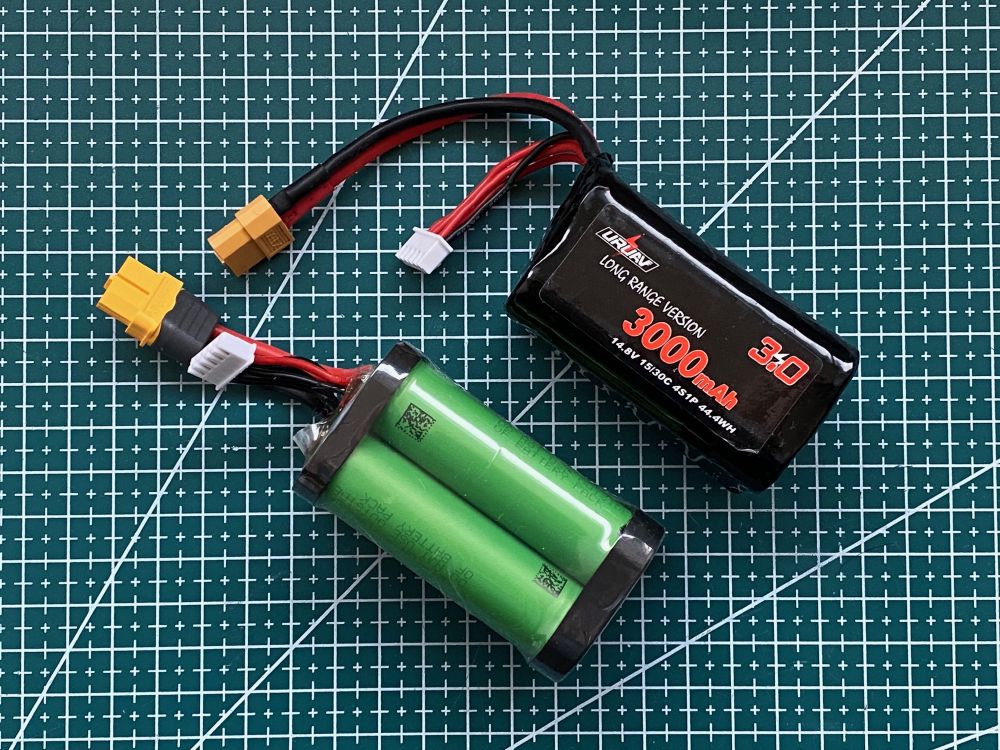Choosing a Li-ion battery pack for FPV drone

For a long time Li-ion battery discharge current capabilities where unsuitable for high current applications like drones. However Li-ion chemistry advanced enough where they become viable for certain types of flying.
In FPV we are used to 100C-150C rated batteries. C rating indicates the battery discharge capabilieties related to its capacity: for example 1000mAh 100C will provide 100A discharge current, or 1500 mAh 160C will give 240A (see this calculator). On the other hand small Li-ion battery packs were only capable of 10A-15A of discharge current. Nowadays we can find Li-ion packs with 30A-90A discharge or even more in larger batteries.
Given that these packs can now produce enough current for FPV drones a lot more people got interested because of their other advantages like much higher energy density, better life span and much simpler maintenance. However Li-ion packs still only makes sense on larger or long range drones. Acrobatic flying or racing still needs that top discharge rate of LiPo batteries.
How Li-ion packs are made?
Li-ion packs are quite simple and can be DIY made at home. The most basic part of these packs is Li-ion cells. They are typically either 18650 or 21700 format. Those are the same battery cells that go into electic cars, laptop computers and other electronics. Here are the most suitable cells for FPV battery packs:
| Sony VTC6 | Molicel P30B | Molicel P28A | Sony VTC6A | Molicel P45B | Molicel P50B | |
|---|---|---|---|---|---|---|
| Format | 18650 | 18650 | 18650 | 21700 | 21700 | 21700 |
| Discharge | 30A | 36A | 35A | 40A | 45A | 50A |
| Capacity | 3000mAh | 3000mAh | 2800mAh | 4000mAh | 4500mAh | 5000mAh |
| Weight | 47g | 47g | 46g | 72g | 70g | 70g |
| Energy density | 64mAh/g | 64mAh/g | 61mAh/g | 56mAh/g | 64mAh/g | 71mAh/g |
A single cell can deliver from 30A to 50A of current which is low compared to 100A-200A you get from LiPo batteries but you can pull a higher current by using multiple cells in parallel. For example, 2x Molicel P50B cells will be able to deliver 100A and 3x P50Bs will give you 150A. The only downside is using multiple cells in parallel will make a larger pack. 2p (2 parallel cell) configurations typically only makes sense on larger 7" drones due to their size and weight. 10" drones may have a 3p battery pack with 3 parralel cells and large planes can even use 4p, 5p or larger configurations.
Parallel cell groups are then connected in series to produce the final battery pack at desired voltage. These connections are made by welding nickel strips using a spot welder. It may sound like a complicated process but it can easily be done at home with a small spot welder like DH20 Pro. The strips used to connect the cells are typically made of nickel plated steel or pure nickel. Strip material, thickness and width may limit the discharge capabilities of the cells.
| Nickel plated steel | Pure nickel | Copper | |
|---|---|---|---|
| 0.10mm x 10mm | 7A | 10A | 30A |
| 0.15mm x 10mm | 10.5A | 15A | 45A |
| 0.20mm x 10mm | 14A | 20A | 60A |
Based on over-current capacity of nickel plated steel at 7A/mm2, pure nickel 10A/mm2, copper 30A.
Nickel plated steel is the most common option because it’s cheap and easy to weld. However it’s far from the best conductor. Once you exceed its current carrying capacity it will heat up wasting energy and introducing voltage sag. Copper is a very good conductor with the least resistence thus the best current carrying capacity. However low resistance makes it almost impossible to DIY weld: welding current just passes through without creating enough heat to produce a strong weld.
There are a few different options to improve battery discharge performance:
- Thicker strips or multiple layers of nickel strips: more material allows more current to pass. On a 2P battery you could use 2 strips to make series connection thus doubling the current.
- Pure nickel is often used on higher discharge batteries to improve performance. It can still be welded using traditional methods.
- Nickel strips on top of copper strips (copper nickel sandwich) makes it possible to weld a very thin copper strip (up to 0.1mm) by welding a nickel strip on top of it. Higher nickel resistence creates enough heat to weld through both strips. It requires a powerful welder to produce a good weld this way.
- Copper nickel composite strips provide simplicity of nickel welding with added performance of copper. It’s a new product with not yet proven performance. I will be testing it soon.
Let me know in the comments if you’d like to know more about how I build my own Li-ion packs.
Which Li-ion pack to purchase?
Most FPV retailers now carry 4S1P 3000mAh or 6S1P 4000mAh Li-ion packs. Make sure they are 30A/35A rated packs which will typically have Sony VTC6 or Samsung INR21700-40T cells. Their performance is good enough for lightweight long range quads, wings and planes.
For top performance battery packs look at Upgrade Energy (US). They have batteries with the best cells like Molicel P45B or Molicel P50B (red model). Their batteries can deliver the full potential of these cells because they are laser welding copper connections. They are quite expensive and may be difficult to get outside the US. Building a Li-ion battery pack yourself could save you ~30-50% but be aware of the complexity welding copper and the gear and time required.
I’d like to tear apart some of Upgrade Energy and other readily available packs for testing. Maybe I’ll start a GoFundMe campaign so I can get some packs for destruction. Let me know in the comments if you’d be interested to read about it.